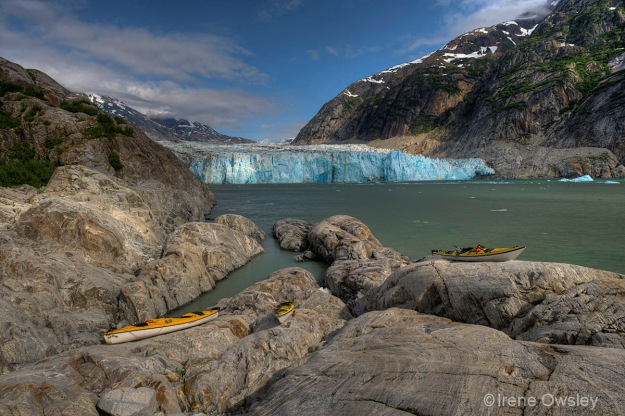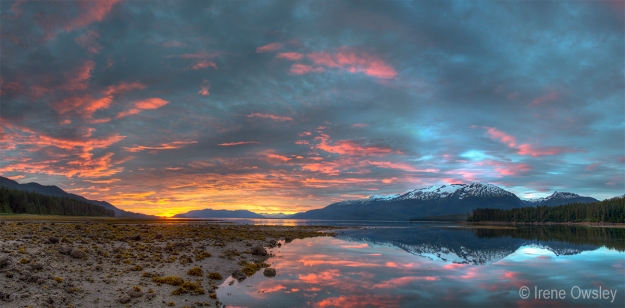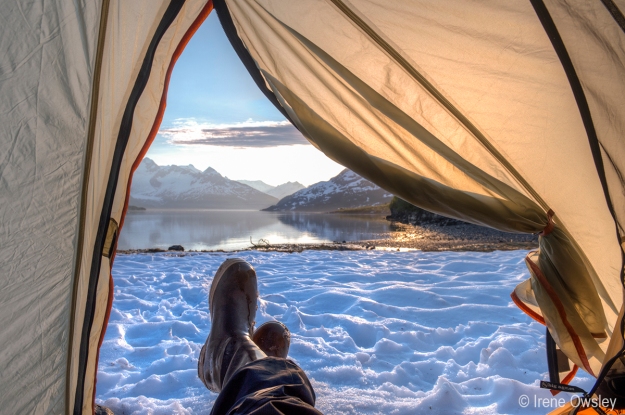Wednesday, November 4, 2015
Friday, October 9, 2015
Igniting the Primordial Fire: A Guest Post by Annalisa Barelli
Welcome to guest blogger Annalisa Barelli, who lives and works on Washington state's Olympic Peninsula. Through her visual art, writing, teaching, and activism, she exemplifies what can happen when art, nature, and advocacy link arms.
 |
| Autumn Sea (2009) mixed media on wood |
Life is a collection of moments. Even when we gaze outward from earth into the depths of space, we find history reflected in the stars. Sitting on the edge of a mountain, I contemplate my place. The mountain was birthed millions of years prior to my existence, erected from fiery eruption, chiseled by glacier, smoothed by tide. As I rest upon the basalt rock, I feel into all of the moments that have made my own life possible. It is a lineage so long that faces and places disappear into the void, like the uncharted galaxies above. In this expansive view, the separateness that my mind constructs fades and I am returned to a place of connection.
 |
| Within The Flame (2015) mixed media on canvas |
 |
| She, Untitled (2012) mixed media print of watercolor and digital alteration on paper |
It is my belief that the role of art is to challenge the mundane and carry visions farther, to bring together what was once perceived as separate, and to make each moment as beautiful as possible. The word inspiration at its root means to breathe. Just as the spark needs a wind to ignite the flame, our lives need inspiration for sustenance. For me, the greatest responsibility of art is legacy. It is not significant that the paintings or stories live on long after I am gone. What is most important is that I live colorfully, moment to moment, leaving my own unique mark on the world around me.
I hold firm to the belief that we are all artists because we are all expressions of creation. When we open to our inherent nature, our moments become the canvas, the stories, and the songs. When we connect to that inner fire and recognize our own life as an expression of a much bigger creative force, we add more to the present moment. Our presence is transformed into a living, breathing art that endures long after we've left our mark.
Annalisa Barelli is a visual artist, writer, and environmental activist. She resides on the Olympic Peninsula of Washington State where she creates, teaches, and inspires. She is involved with the Protect the Olympic Peninsula group; learn more on her blogpost Activism as Art. You can visit her website at annalisabarelli.com and purchase her work at shop.annalisabarelli.com.
Tuesday, September 8, 2015
Step into Nature: FREE SIGNED COPY and Guest Post by Patrice Vecchione
Welcome to guest blogger Patrice Vecchione, whose new book Step into Nature: Nurturing Imagination and Spirit in Everyday Life, is, says David Rothenberg, "a true workbook for the senses." As poet Jane Hirshfield writes, this book "...illumines the intimate connection between inner and outer, contemplative and wild, and shows the reasons these connections matter." Continue reading to find out how to get a free signed copy!
Monterey Pine, Jacks Peak Park, California.
That a connection exists between nature and imagination is something I knew from way back, even as a city kid at a remove from unfettered natural enclaves and expanses. Most all children have an innate love of snow on the tongue and wind through their hair. Young spirits are fed by the natural world peeking through, even in small ways. Kids have fewer filters to separate them from that first, true human home.
My parents graced my young life with art--taking me to museums, concerts, and the ballet. A direct infusion into nature herself was not their métier and was limited to brief forays at various parks and trips to the Bronx Zoo.
As a kid, nature actually frightened me, its unpredictability did. Summer storms replete with thunder and lightning rumbled that point home. Through art, however, I began a sustained a relationship with the earth, liked how the denseness of a sketched forest removed me from the museum floor and into its haven. Images of earth’s places wholly drew me in way before I began to recognize and frequently experience the pull of firsthand nature enlarging imagination.
"Winged Man" by Patrice Vecchione
Some years back, having been a long distance bike rider who,
due to arthritis, had to give up even short rides, I took to the woods, for the
banal desire to get exercise outdoors, not in a gym. It began innocently
enough—I’d walk for an hour or so, get hot and sweaty and return home happily
tuckered out.
The place I chose to walk was Jacks Peak Park, a 500 + acre densely wooded park
ten minutes from home. What
I’d ignorantly assumed was a park with few trails I quickly discovered possessed
over 10 miles of interconnecting paths and more if one includes those that go
off onto private property.
At first I went walking with little more than car keys and a
full water bottle but, after a few weeks, I needed more. Words started coming
at me that I felt compelled to write down—a back pocket pen and no paper meant
my right hand and inner arm became my canvas, got filled with ink. Once home, I
transferred those words to paper.
Notebook of "Finds:" feathers from two hawks and a Great Northern Flicker.
With a back-of-the-junk-drawer notebook added to my pocket I began walking not only for exercise but in order to listen and respond. The forest had begun talking to me—the wind whispered, the trees insisted I pay attention. Pay attention to what? To them and to the play between the whole of that natural place and her individual parts and my own imagination. It was just that I’d walk and hear things and be curious about what I was hearing and thinking and have to stop to listen, record, respond.
What I heard and saw and smelled and touched turned into poems, essays, and collages. There I’d be mid-step watching and waiting—two mice chatting in the bushed, a squirrel leading my way down a path, the frightening loudness of a tree falling nearby. A small yellow flower with red spots at its center made me bend into the brush for a photograph. In late summer all the foliage at the end of life became newly beautiful to my eyes. Having previously preferred high heels to hiking boots and being anything but a nature aficionado, I became a changed woman, an artist anew.
This link between nature and imagination was something I had
to explore, to write about. I felt a book coming on. Luckily, my literary agent
saw the value in it too, as did Simon & Schuster/Beyond Words/Atria Books.
My book was bought on proposal and I received six months to write the book. Six
months? As the ink on my signature dried I doubted that possibility. However,
those six months were the happiest of my 58 years.
The wind wrote my book and the Great Northern flickers did.
The rolling rocks gave their unrestrained input. The mountain lions I knew were
somewhere lurking added elements of surprise to the words I found. I wrote it
in the way nature revealed herself to me—one step at a time.
After about another six months Step into Nature: Nurturing Imagination and Spirit in Everyday Life
became a book to hold with pages to turn. It explores the unique identities of places, the link
between imagination, inspiration and intuition, how engaging our many senses can
expand our creative abilities and revive our spirits, the value of solitude in
artistic practice, and more.
Gotta go—nature calls. Who knows what next words may call!
Now that you've heard from Patrice, you're likely enticed to hear more. And you can. Patrice is offering one signed copy for free. If you want it, here's what you do:
1. Comment on this blogpost between now and October 15.
2. Raffle-style, I'll pick one name to get a book.
3. Check back after October 15, or sign up to "follow" this blog and you'll get an email when the winner is posted.
4. If you're the lucky winner, email me your address, and you'll get your free, signed copy of Step into Nature.
5. If you're not the lucky winner, never fear, you can buy the book here or here.
Patrice Vecchione is the author of Writing and the Spiritual Life and two books of poetry, and is the editor of numerous anthologies. She offers creative writing and collage workshops at universities, libraries, parks, and community center, including Esalen Institute.
She lives in Monterey, California, with her best beloveds--her husband, two cats, and her garden. Connect with Patrice on Twitter @VecchioneAuthor and Facebook
PatriceVecchioneAuthor and www.patricevecchione.com.
Wednesday, September 2, 2015
Monday, August 17, 2015
Residing in Wilderness: A Guest Post by Irene Owsley.
Welcome to guest blogger Irene Owsley, whose images from three artist residencies in Alaska's wilderness have given all of us a new perspective on the wild. This guest post first appeared on the blog Thinking Wilderness.
Traveling by kayak for 8 days with two wilderness rangers during an artist residency program in the Tracy Arm-Ford’s Terror Wilderness of the Tongass National Forest, Southeast Alaska, I was intensely aware of a world defined by moving water. We paddled up the fjord, filled water jugs from cascading waterfalls, dodged growlers and bergy bits in our kayaks and admired icebergs from a safe distance.

View from my kayak, Harriman Fjord, Prince William Sound. L-R: Cascade, Barry & Coxe Glaciers. Nellie Juan-College Fjord Wilderness Study Area, Chugach National Forest.
It rained occasionally, and the sun was elusive. Fog clung to the spruce branches above us, leaving fat droplets on the undergrowth we hiked through. At the end of Endicott Arm loomed Dawes Glacier, the great carver of this landscape. We camped nearby, next to a glacial stream, itself a microcosm of the mighty glacier beyond, alive with sound and movement where water was constantly flowing, crushing and moving rock, working on the palette of the landscape.

Single Shot: View of Dawes Glacier, Endicott Arm, with kayaks in the foreground. Tracy Arm-Ford’s Terror Wilderness, Tongass National Forest, Southeast Alaska
And that’s what I was doing, too, trying to make an image of these dynamic forces at work, setting up my tripod in the shallow part of the stream. I was captivated by the smooth granite slide, the multicolored rocks at its base, and the tide which moved in and out, its flow competing with the outpouring from the mountain behind. The setting was primeval, exuding the essence of self-willed landscape, to echo the words of Howard Zahniser, principal author of The Wilderness Act of 1964.

Sunset at low tide, Sanford Cove. Chuck River Wilderness, Tongass National Forest, Southeast Alaska.
At this spot, I shot several vertical images and later stitched them together in Photoshop to create a panorama of the scene that had made such an impression on me. It was one of several panoramas I made as my contribution to the Voices of Wilderness artist residency program conceived, organized and run by a truly dedicated wilderness ranger and artist, herself, Barbara Fischer Lydon, now based out of the Glacier Ranger District in Girdwood, Alaska.

View from Black Sand Beach, Harriman Fjord, Prince William Sound. L-R: Cascade & Coxe Glaciers. Nellie Juan-College Fjord Wilderness Study Area, Chugach National Forest.
The goal of the Voices of Wilderness program is to bring artists into the wilderness and allow them to create pieces, in their particular medium, that speak to the values of wilderness. The work of many artists was collected over a four-year period for a 2014 exhibition that traveled to seven museums and communities in Alaska, culminating with a show at the Anchorage Museum – all in celebration of the 50th anniversary of The Wilderness Act. The traveling exhibition brought huge awareness to this milestone in conservation history and spurred public engagement with wilderness, both through the efforts of the artists and the participating public lands throughout Alaska.

Single Frame: View from my tent down Harriman Fjord, Prince William Sound. Nellie Juan-College Fjord Wilderness Study Area, Chugach National Forest.
For me personally, the value of my participation in Voices of the Wilderness has been immeasurable. It offered me the unique opportunity for self-supported living in designated wilderness areas in Alaska for 7-10 days at a time which inspired new expression (through my photography) and the articulation of much that lay buried within – this love of all things wild. The experience lifted me to a higher level of understanding where “wild” is concerned and made me acutely aware of the critical need to preserve and support what wild areas we still have. Just as importantly, I was introduced to other artists and wilderness activists who became models to me through their fierce support for wilderness.
![[FEATURED IN SMITHSONIAN EXHIBITION] Glacial stream, Endicott Arm. Tracy Arm-Ford’s Terror Wilderness, Tongass National Forest, Southeast Alaska.](https://thinkingwilderness.files.wordpress.com/2015/02/owsley_120722_streambed_endicott.jpg?w=625&h=316)
[FEATURED IN SMITHSONIAN EXHIBITION]
Glacial stream, Endicott Arm. Tracy Arm-Ford’s Terror Wilderness, Tongass National Forest, Southeast Alaska.
Glacial stream, Endicott Arm. Tracy Arm-Ford’s Terror Wilderness, Tongass National Forest, Southeast Alaska.
And not least, my image of “Glacial Stream, Endicott Arm,” (above) is included in the Smithsonian’s exhibition, “Wilderness Forever,” at the National Museum of Natural History, one of thirteen finalists chosen from over 5000 entries. My image was awarded first place in the professional category for “Scenic Landscape.”

View of Tracy Arm near Sawyer Glacier. Tracy Arm-Ford’s Terror Wilderness, Tongass National Forest, Southeast Alaska.
Irene Owsley, a freelance photographer, specializes in the outdoors and travel, particularly in northern regions. Her work has appeared in such magazines as Canoe & Kayak, Sierra, National Parks, Earthwatch, and Natural History and in the publications of several conservation organizations. Since 2011, she has been accepted to participate in three artists residencies in Alaska’s wilderness. A long-time resident of Washington DC until just recently, Owsley found the “wild” in this large metropolitan area by creating a body of work called “Wild Washington,” with images from the riparian areas along the Potomac River. She has exhibited her work in galleries and has been profiled in Rangefinder, Photographer’s Forum, and Nikon World magazine. A new resident of New Mexico, Owsley is focused on producing large scale panoramic landscapes as a way to explore her new home. She serves on the national board of ASMP (American Society of Media Photographers), promoting best business practices for photographers. www.ireneowsley.com
Tuesday, July 7, 2015
Karman Vortices and other Earth Art.
The following images come from the USGS Earth Resources Observation and Science Center whose acronym is (yes, it really is) EROS. The EROS Center has an incredible slideshow of satellite images of our one, our only home.
"Our common home," as the subtitle to Pope Francis' encyclical, Laudato Si', reminds us.
"Our common home," as the subtitle to Pope Francis' encyclical, Laudato Si', reminds us.
Edrengiyn Nuruu August 1, 1999. The Edrengiyn Nuruu forms a transition zone between the Mongolian steppes to the north and the arid deserts of northern China to the south.
Karman Vortices September 1, 1999. Each of these swirling clouds is a result of a meteorological phenomenon known as a Karman vortex. These vortices appeared over Alexander Selkirk Island in the southern Pacific Ocean. Rising precipitously from the surrounding waters, the island's highest point is nearly a mile (1.6 km) above sea level. As wind-driven clouds encounter this obstacle, they flow around it to form these large, spinning eddies.
Lena Delta July 1, 2001. The Lena River, some 2,800 miles(4,500km) long, is one of the largest rivers in the world. The Lena Delta Reserve is the most extensive protected wilderness area in Russia. It is an important refuge and breeding grounds for many species of Siberian wildlife.
Dragon Lake December 1, 1999. Nicknamed "Dragon
Lake," this body of water is formed by the Bratskove Reservoir, built
along the Angara River in southern Siberia, near the city of Bratsk. This image
was acquired in winter, when the lake is frozen.
Bolivian Deforestation August 1, 2000. Once a vast carpet of healthy vegetation, the Amazon rain forest is changing rapidly. This image of Bolivia shows dramatic deforestation in the Amazon Basin. Loggers have cut long paths into the forest, while ranchers have cleared large blocks for their herds. Fanning out from these clear-cut areas are settlements built in radial arrangements of fields and farms. Healthy vegetation appears bright red in this image.
Thursday, June 11, 2015
Muriel Rukeyser: This moment is real.
Sundews, Prince William Sound, Alaska.
"This moment is real, this moment is what we have, this moment in which we face each other, and if a poem is any damn good at all, it invites you to bring your whole life to that moment, and we are good poets inasmuch as we bring that invitation to you, and you are good readers inasmuch as you bring your whole life to the reading of the poem."
~ Muriel Rukeyser
"This moment is real, this moment is what we have, this moment in which we face each other, and if a poem is any damn good at all, it invites you to bring your whole life to that moment, and we are good poets inasmuch as we bring that invitation to you, and you are good readers inasmuch as you bring your whole life to the reading of the poem."
~ Muriel Rukeyser
Subscribe to:
Posts (Atom)















